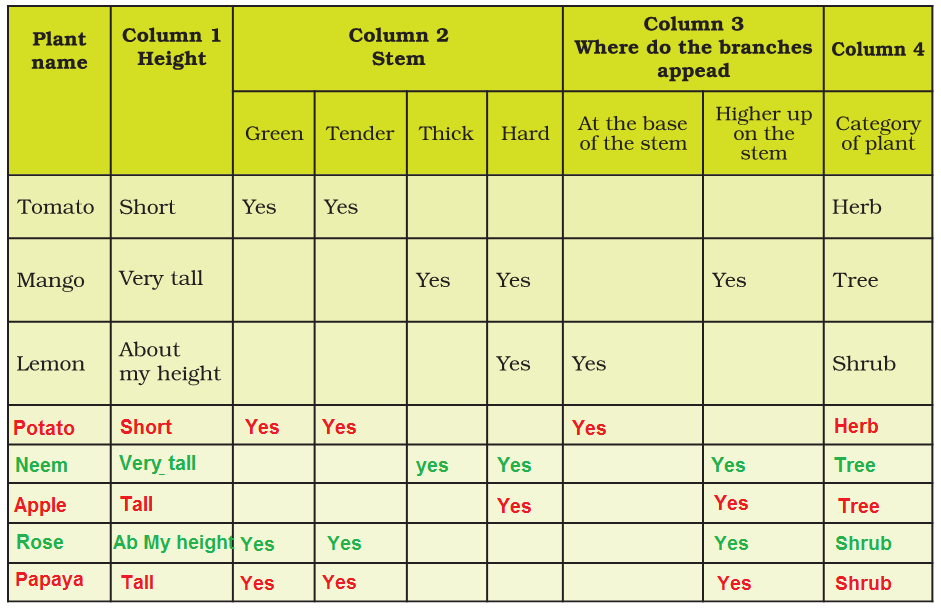Table of Contents
NCERT Class 6 Science Chapter 7, Getting to Know Plants Activity Solution
Activity 1
Activity 1 asks us to observe the stem of the various plants, look at the place from where branches appear and classify them.
Answer: We look at the various stems of different plants. Some are soft and can be easily bent while some are hard to bend. In some plants, branches appear at the ground while in some plant branches are at some height.

We classify the plants as herb, shrub or tree by these characteristics.
Herb: A plant with a green and tender stem whose branches are near to the ground.
Shrub: A plant with not so thick stem and branches nearby.
Tree: A plant with thick stem and branches are away from the ground.
Activity 2
Activity 2 asks us to cut the stem of a plant and dip into blue ink coloured water and see what happens.
Answer: A plant needs water for its survival. It absorbs coloured water. As a result, we see bluish leaves and flowers.
Activity 3
Activity 3 asks us to place a leaf beneath the paper and rub the paper with a pencil.
Observation: Veins of the leaf appear on the paper.
Explanation: Veins are the water transport organs of a plant. They are hard tube-like structure. When we place a paper on leaf and rub it hard veins make an imprint on the paper.
If you observe the vein arrangement, then you will get either an unorganised vein or parallel vein. We call such veins as reticulate and parallel vein, respectively. Mango, neem etc. have reticulate veins while some plants like jasmine and maize have parallel veins.
Activity 4
Activity 4 asks us to cover a few leaves of a plant with a polythene bag, tie them and observe them after a few hours,
Observation: Tiny droplets appear on the polythene bag.
Explanation: Plant releases water vapour into the atmosphere. We call it Transpiration.
When we put the polythene bag on leaves, water vapour deposit on the bag by the process Condensation which we studied during the separation of mixtures.
Activity 5
Activity 5 asks us to test a plant leaf with an iodine solution.
Observation: Iodine turns the leaf blue.
Explanation: Plant prepares their food from carbon dioxide and water in the presence of sunlight. This food is stored in leaf and other various parts of the plant in the form of starch. So when we treat the leaf with an iodine solution, it turns the leaf blue.
Q. What is the purpose of boiling the leaf in spirit solution before treating with an iodine solution?
You must have read in the book that we first boil the leaf in spirit. The purpose of doing this is to break the leaf cells. By doing this, green pigments of the leaf goes into the solution. A colourless leaf is easy to stain. Now iodine solution work upon starch and gives a contrasting blue colour.
Activity 6
The activity asks us to dig two small plants with roots and plant them separately, one with the root and another without root.
Observation: In a few days, the plant without the root wilt down.
Explanation: Plant requires minerals and water through the soil to prepare their own food. They absorb minerals and water through the root. In the second plant, the root was absent, so the plant did not get required mineral and water. As a result, plant wilt-down.
Activity 7
Activity 7 asks us to germinate seeds of gram and maize on wet cotton and see if we can separate their root from cotton.
Observation: Separation of the gram root was little more difficult than uprooting maize root from cotton.
Explanation: Activity 8
Activity 8
Activity 8 asks us to examine the roots of germinating seed in activity 7.
Answer: Root of maize is longer without any secondary roots while gram root has secondary roots.
Explanation: Type of roots depend on the type of plant and the environment. Maize grows in areas with less water. Its root go down in the soil to absorb water. While if we compare gram, it grows in well-irrigated soil. In such soil water is present in a sufficient amount. So its root is designed to absorb water at a lesser depth. We can understand this from the further development of root.
Activity 9
The activity asks us to study the relation between the type of root and type of venation.
Answer: As we have seen in activity 3 above, Venation is the arrangement of veins in plants. Plant have either parallel venation or reticulate venation. Venation depends on the arrangement of xylem. In plants with a taproot, xylem is more organised and advanced. Such plants have parallel venation. While in plants with fibrous root-like gram xylem is unorganised and less advanced. They have reticulate veins.
Next: Getting to Know Plants Exercise answer.
See also: Chapter 8 Body Movements Activity Answers.
Chapter 6 Changes Around us Activity Answer.
Where is activity 10 and 11?
10 and 11 activity
Where is table 7.2
where is activity 10 and activity 11 of this chapter